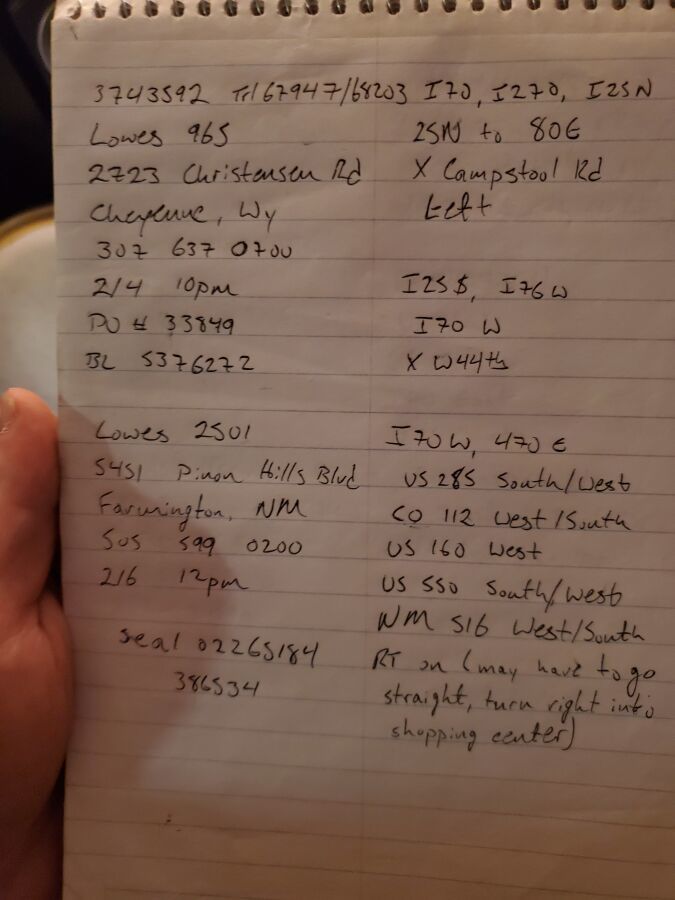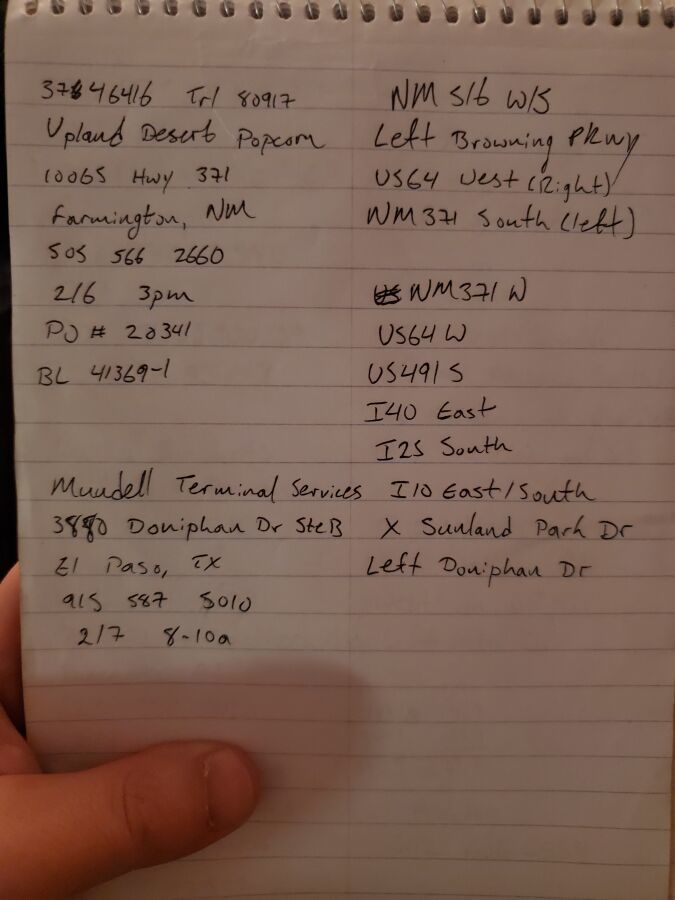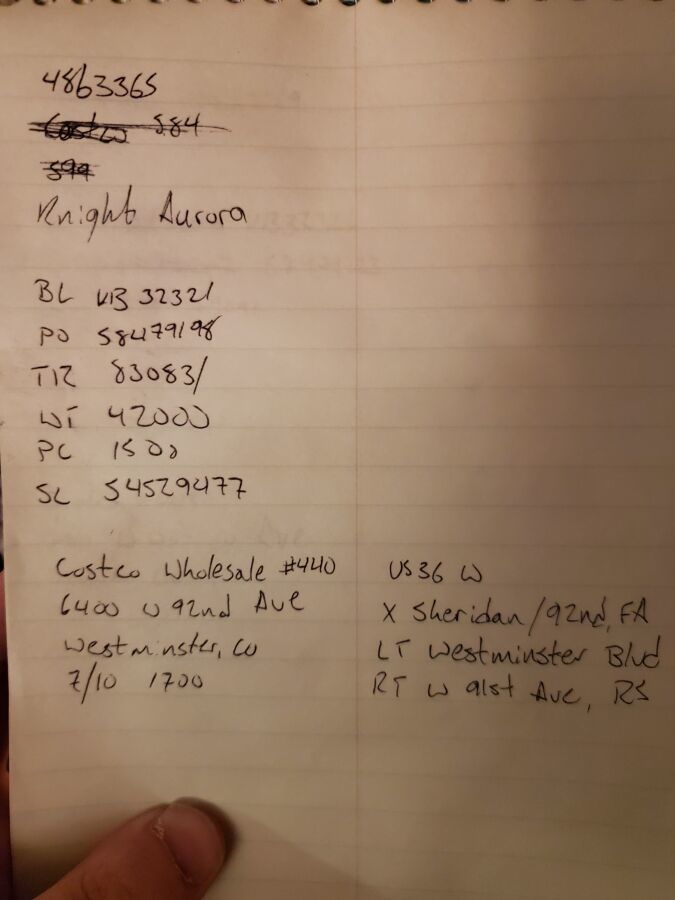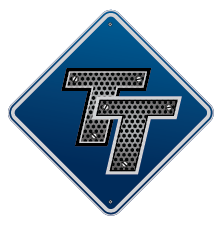I Need Help With Trip Planning
Topic 29863 | Page 1
Trip planning is tougher than I thought. I Really want to learn the old school way using the atlas, and not rely on a gps or technology. I have taken several routes suggested by the gps and just followed them or tried to on the atlas and have really struggled, to say the least. You have to have a good memory and good eyes lol jumping back and forth through the states.
I will just keep practicing and hopefully it will get easier with time. It is a skill that is for sure.
I kept a steno pad on hand so I could write out customer information on the left side, and all my directions, interchanged, and even intersections on the right side -- take notes as you go.
The human brain finds it really easy to skip up or down as you scan left or write, so that was how I tried countering it, by writing each step as I identified it on the atlas. After getting the initial framework on the atlas I'd double check via Google maps and satellite, making any final notes about hidden intersections, hard to spot driveways into facilities, things like that. I could take a photo of my old work if you'd like.
That would be great if it's not too much trouble. I am becoming more familiar with using the atlas, but it's still tough.
The other day hwy 35 somewhere in W. Virginia to Illinois in a small corner partially blocked by a city blow up alluded me for about a half hour and I just had to walk away...lol
Finally found it though...thanks for the tips
Ohio and P.A were in the mix as well...Even the wife said nope it's not there....lol

Hopefully this is neat enough to understand -- on the left side is that company's assigned trip number (Knight), the shipper , their address, city/state, phone number, scheduled pickup, and any other numbers necessary for the pickup. By this point I was intimately familiar with Lowe's process, but when you're just starting out, any number that looks useful in whatever your company uses as load info, write it down.
Following that on the left side is the consignee/receiver, and all the same information (underneath is the seal, but after I'd gotten my act down that goes underneath BL (Bill of lading).
On the upper right are my directions from my previous consignee or origin location (in this case it would have been the Knight yard).
The bottom right location is the stuff most useful to you: that's a turn-by-turn/junction-by-junction order of every single street or highway to get to my consignee (including notes, where you can see I wrote possible alternatives I may need to use when making my final approach). I get all of the highways from the atlas, and then I pull those notes using google maps, but I am very strong proponent of writing all of this down for a variety of reasons: first is simple tech common sense. If your GPS unit breaks, you have a handy fallback. Second is this means you pay more attention to all of your turns. I treated it as a game to remember as much of my directions as possible without referring to my notebook. Third (never ideal, but happens), makes it feasible to grab the notebook and double check your interchange as you're approaching a highway junction without fiddling with any tablets or computer settings. The fourth (and the one that made my life SO much easier): it has ALL of your pickup/dropoff information there, so when you get to your customer and you go check in? You are always ready to go whether you're checking in at a warehouse or DOT wants any of your information. Makes you look real professional. :)
Consignee:
The customer the freight is being delivered to. Also referred to as "the receiver". The shipper is the customer that is shipping the goods, the consignee is the customer receiving the goods.
Shipper:
The customer who is shipping the freight. This is where the driver will pick up a load and then deliver it to the receiver or consignee.
DOT:
Department Of Transportation
A department of the federal executive branch responsible for the national highways and for railroad and airline safety. It also manages Amtrak, the national railroad system, and the Coast Guard.
State and Federal DOT Officers are responsible for commercial vehicle enforcement. "The truck police" you could call them.
HOS:
Hours Of Service
HOS refers to the logbook hours of service regulations.OWI:
Operating While Intoxicated
This is the trip following my delivery at the Lowes store in Farmington, NM -- same principle applies in the upper right.

Finally: a standalone trip where I've got my order of things written down refined -- my trailer and seal numbers have moved to where they should be, underneath the BL#. "Knight Aurora" was just my shorthand for the Knight terminal in Denver. I spent almost a year as a local driver so there was less need to specify addresses of everywhere I went. When it was somewhere new like the Costco store you see on the bottom though, I went back to my old OTR method. (FA= follow around, RS=right side, LS=left side.)

Terminal:
A facility where trucking companies operate out of, or their "home base" if you will. A lot of major companies have multiple terminals around the country which usually consist of the main office building, a drop lot for trailers, and sometimes a repair shop and wash facilities.
OTR:
Over The Road
OTR driving normally means you'll be hauling freight to various customers throughout your company's hauling region. It often entails being gone from home for two to three weeks at a time.
OWI:
Operating While Intoxicated
Sorry if that was too much of an infodump -- let me know if you have any other questions. :)
That's awesome, thanks for the tips. I am in service work and frequently use directions. Just not in a huge truck where mistakes sometimes can't be reversed without many negative conseques. Plus I am driving in somewhat familiar terrain, and dont have to worry about turning around, low bridges, or missing a turn ect...lol
I like your like your technique...simple but very detailed. It has already helped me in that respect, plus given me some more important things to consider. I appreciate you taking the time to post the photos, and explaining why you do it this way...Makes a lot of sense
I will be leaving in about 14 days on my first big trip, about 1400 miles from home through about 5 different states, to start my new job in trucking... I am a bit nervous, but mostly looking forward to the challenge and learning to be the best I can be out there. Not only for my family, and myself, but for my new trucking family as well....
I just purchased my first pair of flip flops and matching pajama set for the occasion....JUST KIDDING! LoL
That's awesome, thanks for the tips. I am in service work and frequently use directions. Just not in a huge truck where mistakes sometimes can't be reversed without many negative conseques. Plus I am driving in somewhat familiar terrain, and dont have to worry about turning around, low bridges, or missing a turn ect...lol
I like your like your technique...simple but very detailed. It has already helped me in that respect, plus given me some more important things to consider. I appreciate you taking the time to post the photos, and explaining why you do it this way...Makes a lot of sense
That's another advantage to this imo -- same as everything else really. You can note possible low bridges, weight restrictions, etc. on that sheet next to the relevant street or highway.
For general intents and purposes, any distance you travel across mixed terrain you can calculate around an average of 50-55mph. I don't know if it applies to all cities but I found in LA things tended to average about 30mph. Anytime you're in the mountains, cut your average speed in half (even if you're empty -- it's always better to over budget time.)
Are you going to be running Northeast regional , or the full 48?
Regional:
Regional Route
Usually refers to a driver hauling freight within one particular region of the country. You might be in the "Southeast Regional Division" or "Midwest Regional". Regional route drivers often get home on the weekends which is one of the main appeals for this type of route.
New Reply:
New! Check out our help videos for a better understanding of our forum features

















Preview:








 TT On Facebook
TT On Facebook
Trip planning is tougher than I thought. I Really want to learn the old school way using the atlas, and not rely on a gps or technology. I have taken several routes suggested by the gps and just followed them or tried to on the atlas and have really struggled, to say the least. You have to have a good memory and good eyes lol jumping back and forth through the states.
I will just keep practicing and hopefully it will get easier with time. It is a skill that is for sure.